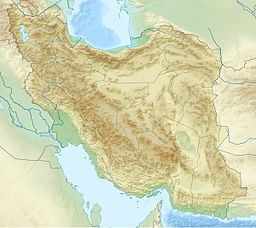Namakzar-e Shahdad
| Dasht-e Lut | |
| Desert | |
| Country | Iran |
|---|---|
| Coordinates | 30°36′18″N 59°04′04″E / 30.60500001°N 59.0677777878°ECoordinates: 30°36′18″N 59°04′04″E / 30.60500001°N 59.0677777878°E |
| Length | 480 km (298 mi) |
| Width | 320 km (199 mi) |
| Area | 51,800 km2 (20,000 sq mi) |
| Biome | Desert |
| UNESCO World Heritage Site | |
| Criteria | Natural: (vii), (viii) |
| Reference | 1505 |
| Inscription | 2016 (40th Session) |
|
[]
|
|
The Lut Desert, widely referred to as Dasht-e Lut (Persian: دشت لوت, "Emptiness Plain"), is a large salt desert located in the provinces of Kerman and Sistan and Baluchestan, Iran. It is the world's 27th-largest desert, and was inscribed on UNESCO's World Heritage List on July 17, 2016. The surface of its sand has been measured at temperatures as high as 70 °C (159 °F), making it one of the world's driest and hottest places.
Iran is climatically part of the Afro-Asian belt of deserts, which stretches from the Cape Verde islands off West Africa all the way to Mongolia near Beijing, China. The patchy, elongated, light-colored feature in the foreground (parallel to the mountain range) is the northernmost of the Dasht dry lakes that stretch southward 300 kilometers (190 mi). In near-tropical deserts, elevated areas capture most precipitation. As a result, the desert is largely an abiotic zone.
Iran's geography consists of a plateau surrounded by mountains and divided into drainage basins. Dasht-e Loot is one of the largest of these desert basins, 480 kilometers (300 mi) long and 320 kilometers (200 mi) wide, and is considered to be one of the driest places on Earth.
Area of the desert is about 51,800 square kilometres (20,000 sq mi). The other large basin is the Dasht-e Kavir. During the spring wet season, water briefly flows down from the Kerman mountains, but it soon dries up, leaving behind only rocks, sand, and salt.
The eastern part of Dasht-e Loot is a low plateau covered with salt flats. In contrast, the center has been sculpted by the wind into a series of parallel ridges and furrows, extending over 150 km (93 mi) and reaching 75 metres (246 ft) in height. This area is also riddled with ravines and sinkholes. The southeast is a vast expanse of sand, like a Saharan erg, with dunes 300 metres (980 ft) high, among the tallest in the world.
...
Wikipedia


